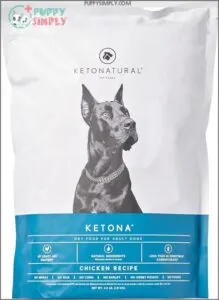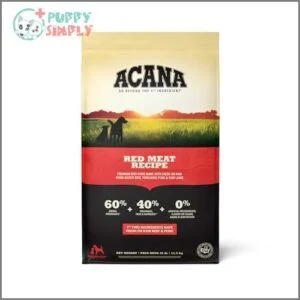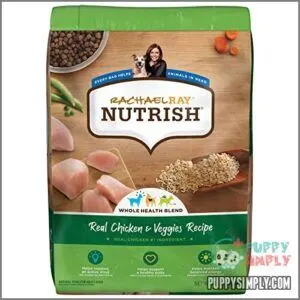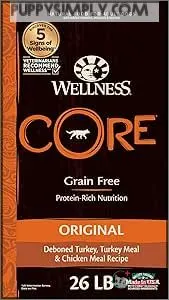This site is supported by our readers. We may earn a commission, at no cost to you, if you purchase through links.

Picture your diabetic dog happily wagging its tail, enjoying meals packed with high-quality proteins and low-glycemic carbs.
These ingredients keep blood sugar levels more predictable.
Brands like Taste of the Wild and Orijen offer delectable options that hit the mark.
Fiber and healthy fats play key supporting roles too, helping with weight control and shiny coats.
Ensuring your furry friend enjoys delicious, nutritious meals allows for wagging tails and fewer health hiccups.
Curious about more ways to manage your dog’s diabetes safely and effectively by learning about the right foods to feed them?? Stay tuned!
Table Of Contents
- Key Takeaways
- Managing Canine Diabetes
- Choosing the Right Diabetic Dog Food
- Top 8 Diabetic Dog Foods
- 1. Taste Of The Wild Southwest Wild Boar Dog Food
- 2. Ketona High Protein Grain Free Dog Food
- 3. Purina Pro Plan OM Dog Food
- 4. Orijen Original Grain Free Dog Food
- 5. Acana Red Meat Grain Free Dog Food
- 6. Blue Buffalo Wilderness Chicken Grain Free Dog Food
- 7. Rachael Ray Nutrish Chicken & Veggie Dog Food
- 8. Grain Free High Protein Dog Food
- Additional Health Considerations for Diabetic Dogs
- Creating a Balanced Diet for Diabetic Dogs
- Common Mistakes to Avoid When Feeding Diabetic Dogs
- The Importance of Regular Veterinary Care
- Holistic Approaches to Managing Canine Diabetes
- Cost-Effective Options for Diabetic Dog Food
- Long-Term Prognosis and Quality of Life
- Frequently Asked Questions (FAQs)
- What is the best food to give a diabetic dog?
- Can a diabetic dog eat regular dog food?
- Is chicken and rice good for diabetic dogs?
- What can I give my dog for diabetes at home?
- Can diabetic dogs eat treats or snacks?
- Are there any specific fruits diabetic dogs should avoid?
- Is it necessary to monitor blood sugar levels in diabetic dogs?
- Can diabetic dogs eat a raw food diet?
- Are there any supplements that can help manage diabetes in dogs?
- Conclusion
Key Takeaways
- Think of choosing the right dog food like assembling a tasty puzzle that keeps your furry friend’s blood sugar in check. Focus on foods rich in high-quality proteins and low-glycemic carbs—it’s like hitting two birds with one stone for stable glucose levels.
- Don’t let doggie diabetes get you down! Regular exercise and consistent feeding routines, much like setting a daily schedule, work wonders in preventing rollercoaster blood sugar levels.
- Always remember, fiber and healthy fats are your dog’s unsung heroes. They’re like the batting order in a baseball team—supporting and setting the stage just right for a healthier coat and better digestion.
- Keep your vet on speed dial! Regular check-ups aren’t just a dog-and-pony show; they help adjust insulin and catch any sneaky complications that might pop up. You’ll stay ahead of the game, ensuring a wagging tail all the way.
Managing Canine Diabetes
Managing canine diabetes means keeping your furry friend’s blood sugar in check, just like you wouldn’t want a rollercoaster ride at breakfast.
It’s all about giving the right insulin, healthy eats, and sticking to a cozy routine so Spot can wag his way through life.
Understanding the Condition
Canine diabetes, often likened to a metabolic jigsaw puzzle, primarily involves insulin resistance and impaired pancreatic function.
Your dog’s body struggles with glucose regulation, leading to unpredictable blood sugar spikes.
Detecting diabetes in dogs early offers control and safety, much like discovering the last corner piece of a puzzle.
Effective management is essential, including specific diabetic dog food.
Common Signs and Symptoms
As a dog owner, you may notice some telltale signs of canine diabetes, like increased thirst, frequent bathroom breaks, and unexplained weight loss. These symptoms can sneak up gradually, so staying vigilant is key. Look out for changes in appetite, energy levels, and coat condition – they could indicate an underlying health issue that needs attention.
Canine Diabetes symptoms can include:
- Increased thirst and frequent urination
- Unexplained weight loss or gain
- Lethargy and decreased activity levels
Diagnosis and Treatment Options
When you suspect your dog has diabetes, getting a diagnosis is as important as putting on your shoes before a walk.
Blood sugar monitoring and insulin therapy play starring roles in diabetes management.
Veterinary care might suggest prescription diabetic dog food to stabilize glucose levels.
Consult a veterinary nutritionist for dietary changes.
Importance of Diet and Exercise
Alright, you’ve got the diagnosis down pat, now it’s time to focus on diet and exercise for managing dog diabetes. Here’s the deal:
- Weight Management: Keep your pup trim to reduce risk factors.
- Food Choices: Opt for low glycemic index foods.
- Exercise Routines: Daily walks make tails wag and regulate blood sugar.
Consistent meal frequency and treat alternatives also work wonders!
Choosing the Right Diabetic Dog Food
Choosing the right diabetic dog food for your furry friend can feel like sorting through a giant supermarket, but we’ve got some tips to make this decision easier.
High-quality proteins, healthy fats, and fiber are important to keep your pup’s blood sugar in check and their tail wagging.
Key Nutritional Requirements
When choosing the right diabetic dog food, focus on 3-4 key nutritional requirements. Lean protein sources like chicken, turkey, and fish should make up the bulk of the formula. Healthy fats are important, but limit fat content for overweight pups.
Prioritize low-glycemic carbohydrates and high-fiber options to help stabilize blood sugar.
| Nutrient | Importance |
|---|---|
| Protein | Lean sources for muscle health |
| Carbohydrates | Low-glycemic to prevent spikes |
| Fiber | Aids digestion and glucose control |
| Fat | Moderate amounts for energy and skin/coat |
| Supplements | Omega-3s, probiotics, antioxidants |
Factors to Consider When Selecting a Food
Now that you’ve got a grip on nutritional needs, let’s explore what to look for in diabetic dog food.
Consider:
- Ingredient quality: Seek natural, wholesome sources.
- Glycemic index: Choose low-glycemic carbs to control glucose.
- Fiber levels: High-fiber options help stabilize sugar.
- Food allergies: Beware of ingredients causing reactions.
Importance of High-Quality Protein Sources
Choosing a diabetic dog food isn’t just about balancing act; quality protein takes center stage.
Muscle maintenance matters, so think lean body mass and energy levels.
Options like deboned turkey and pork meal boost health with protein sources.
Mix in chicken fat for a healthy coat, focusing on crude fat levels.
This keeps tails wagging while maintaining blood sugar control.
Role of Fiber and Healthy Fats
You might think of fiber as the unsung hero of diabetic dog diets—helping with weight control and energy levels.
Think dried molasses beet pulp and ground cinnamon as secret ingredients.
Plus, healthy fats like omega-3 and omega-6 fatty acids are key to a shiny coat and good energy.
So, let fiber and fats lead your paw-tner to better health.
Top 8 Diabetic Dog Foods
Choosing the right diabetic dog food can be a game-changer for your furry friend’s health, especially if they have specific dietary needs like avoiding additives.
We’ve rounded up the top 8 vet-approved options to help you navigate the maze of dietary needs for canine diabetes.
1. Taste Of The Wild Southwest Wild Boar Dog Food

Taste of the Wild Southwest Wild Boar Dog Food is like a culinary adventure for your furry friend, with real wild boar as the star.
High in protein and free from pesky grains, this option supports lean, strong muscles.
Your dog will savor the wholesome blend of antioxidants from superfoods like blueberries and raspberries, while specifically-tailored probiotics work wonders for their digestion.
Many dogs howl in approval at the taste, making mealtime a joy, not a chore.
Keep tails wagging with this flavorful, health-focused option.
Best For: This dog food is best for owners who want a high-protein, grain-free option with real meat as the first ingredient.
- Real wild boar as the first ingredient
- High protein for lean muscles
- Probiotics for digestive health
- Shipping concerns have been reported from Amazon
- Some customers have noted issues with packaging
- May be more expensive than other brands
2. Ketona High Protein Grain Free Dog Food

Choosing the right diabetic dog food can be tricky.
Ketona High Protein Grain Free Dog Food stands out with its impressive low-carb, high-protein formula, making it a solid choice for managing your dog’s sugar levels.
Built with 46% protein and only 6% digestible carbohydrates, it closely mirrors the nutritional benefits of a raw diet but offers the convenience of kibble (Source).
Just be aware that some users mention digestive issues; it might be worth testing small amounts first.
Best For: Dogs with diabetes or needing a low-carb, high-protein diet.
- High protein content supports muscle growth and development.
- Low carbohydrate content helps manage blood sugar levels.
- Grain-free formula may be suitable for dogs with sensitivities or allergies.
- Some users reported experiencing digestive issues.
- Price may be considered high by some users.
- Ingredient consistency between the bag and website has been questioned.
3. Purina Pro Plan OM Dog Food

When dealing with canine diabetes, Purina Pro Plan Veterinary Diets OM is a knight in shining armor.
It’s got a high protein-to-calorie ratio and is low in fat and calories, like a well-balanced scale.
This formula also sports natural fiber, keeping digestion in check and weight at bay.
You might worry about the ingredients, but the formula is designed with extra care for effective weight management.
Don’t sweat the small stuff—let Purina help manage your dog’s diabetes with confidence.
Best For: Purina Pro Plan Veterinary Diets OM is best for adult dogs needing weight management, especially those with diabetes.
- High protein-to-calorie ratio for healthy weight loss.
- Low in fat and calories for effective weight management.
- Contains natural fiber for digestive health and satiety.
- Contains whole grain corn, corn gluten meal, soybean hulls, soybean germ meal, soybean meal, pea fiber, wheat gluten, poultry by-product meal. Some pet owners may prefer a food with fewer processed ingredients.
- May not be suitable for all dogs with diabetes. Consult your veterinarian for personalized recommendations.
- Available in only one size (18 lb bag). May not be ideal for households with smaller dogs or those who prefer smaller bag sizes.
4. Orijen Original Grain Free Dog Food

Orijen Original Grain-Free Dog Food is a top-tier choice for diabetic pups, thanks to its biologically appropriate formula.
This nutrient-dense kibble packs 85% animal protein, mirroring a dog’s natural diet.
The grain-free recipe avoids high-glycemic carbs that can spike blood sugar, opting instead for low-glycemic lentils and chickpeas.
Owners rave about Orijen’s commitment to quality – the ingredients are sourced locally and processed with care to preserve important nutrients.
Say goodbye to mealtime headaches and hello to a happier, healthier pup with this veterinarian-approved pick.
Best For: Orijen Original Grain-Free Dog Food is best for dogs with diabetes or those who require a high-protein, grain-free diet.
- High in animal protein, mirroring a dog’s natural diet.
- Grain-free formula avoids high-glycemic carbs that can spike blood sugar.
- High-quality ingredients sourced locally and processed with care.
- May be expensive.
- Strong smell, may be difficult to store indoors.
- Some users reported anal gland issues when fed as a primary meal.
5. Acana Red Meat Grain Free Dog Food

Acana Red Meat Grain Free Dog Food could be your dog’s new best friend, especially if diabetes is a concern. Packed with high-quality proteins like beef and pork, this diet promotes lean muscle development while keeping carbohydrates low.
It includes essential omega fatty acids for a shiny coat and probiotics for a healthy gut. Yes, it’s a bit salty on the wallet, but investing in your furry friend’s health may save on vet bills later. After all, health’s worth its weight in gold!
Best For: Acana Red Meat Grain Free Dog Food is best for dog owners looking for a high-protein, grain-free diet for their adult dogs, especially those with diabetes concerns.
- High in protein and essential omega fatty acids for healthy muscle development and a shiny coat.
- Includes probiotics for a healthy gut.
- Made with high-quality, fresh regional ingredients.
- Can be expensive compared to other brands.
- Some users have reported price increases.
- There have been reports of a class action lawsuit alleging dangerous levels of heavy metals in Acana foods.
6. Blue Buffalo Wilderness Chicken Grain Free Dog Food

You’ll love Blue Buffalo Wilderness Chicken Grain-Free Dog Food for your diabetic dog. Packed with real chicken, it’s a high-protein feast that supports active dogs while being grain-free—meaning no pesky fillers.
This food’s made in the USA from natural ingredients and has no artificial additives, ensuring Rover’s getting nothing but the best.
If your pooch has skin issues, picky eating habits, or needs weight management, it’s a top pick.
Plus, that delicious chicken flavor might even have them doing their happy dance!
Best For: Active adult dogs of all sizes with dietary restrictions or skin sensitivities.
- High-protein, grain-free formula with real chicken.
- Made with natural ingredients and no artificial additives.
- Customer reviews highlight its effectiveness for skin issues, weight management, and picky eaters.
- Some customers have reported longer shipping times than expected.
- May not be suitable for dogs with specific allergies or health conditions.
- Availability of additional formulas with wholesome grains could be considered a drawback for some pet owners.
7. Rachael Ray Nutrish Chicken & Veggie Dog Food
 View On Amazon
View On Amazon Rachael Ray Nutrish Chicken & Veggie Dog Food is a tasty option for your diabetic dog.
Imagine it as a balanced meal, akin to homemade chicken soup for your pooch.
This food offers high-quality chicken and nutrients to support overall health.
It’s like having a nutritionist in your pantry!
Look for benefits like supporting energy and a healthy coat, but keep an eye out—some less-desirable ingredients might sneak in.
Always check with your vet to make sure it suits your dog’s needs.
Best For: This food is best for dog owners looking for a complete and balanced diet for their adult dogs, with a focus on real chicken and supporting overall health.
- Contains real chicken as the first ingredient.
- Includes Nutrish’s Whole Health Blend for supporting a healthy mind, body, and energy level.
- A portion of proceeds is donated to The Rachael Ray Foundation.
- May contain less-desirable ingredients.
- May be difficult to find in larger sizes.
- Some customers have reported issues with customs in Canada.
8. Grain Free High Protein Dog Food

Grain Free High Protein Dog Food is a fantastic option for your diabetic pup. This formula boasts an impressive 44% high-quality protein, primarily from turkey, which helps maintain lean muscle mass.
The grain-free recipe avoids blood sugar spikes from starchy carbs, while omega fatty acids, glucosamine, and probiotics support your dog’s overall health.
Customers rave about the natural, non-GMO ingredients and the positive impact on their furry friend’s energy levels and coat condition. At a reasonable price point, this nutritious food is worth considering for your diabetic companion.
Best For: This grain-free, high-protein dog food is ideal for diabetic dogs and those needing a boost in energy and muscle tone.
- High protein content supports lean muscle mass and energy levels.
- Grain-free formula avoids blood sugar spikes, making it suitable for diabetic dogs.
- Contains natural, non-GMO ingredients for a healthier diet.
- May be pricier than some other dog food options, like vegan dog food brands.
- Transitioning to this food should be done gradually to avoid digestive upset.
- Individual dogs may react differently to the food, so monitoring is essential.
Additional Health Considerations for Diabetic Dogs
When your dog has diabetes, you’ve got more to think about than just blood sugar levels.
Keep an eye on weight.
Watch out for urinary tract infections.
Be mindful of pancreatitis, cataracts, and neuropathy to help your furry friend lead a healthier life.
Obesity and Weight Management
Managing obesity in diabetic dogs is like walking a tightrope!
Weight loss plans and exercise routines are your balancing stick.
Portion control and healthy treats help maintain a proper body condition score.
Consult with your vet—think of them as Banfield Hospitals’ version of the American Diabetes Association.
For senior dogs, gentle exercise keeps them spry!
Urinary Tract Infections (UTIs)
Be aware of urinary tract infections (UTIs) if your dog’s diabetic. They’re like unwanted house guests—nobody wants them, but they occasionally show up.
Watch out for these UTI symptoms:
- Frequent urination
- Cloudy urine
- Accidents in the house
- Licking private parts
Prevent UTIs with a UTI diet, including Blue Buffalo or Wellness Core with brewers dried yeast.
Pancreatitis and Digestive Issues
Pancreatitis and digestive woes can crop up in diabetic pups.
Watch out for signs like vomiting, diarrhea, and abdominal pain.
Steer clear of high-fat foods, which can trigger flare-ups.
Instead, opt for a gentle, low-fat diet rich in digestive enzymes, probiotics, and soothing herbs like fennel and peppermint to ease tummy troubles.
| Ingredient | Benefits |
|---|---|
| Ground Fennel | Reduces inflammation, soothes digestive tract |
| Ground Peppermint | Eases nausea, improves digestion |
| Yucca Schidigera Extract | Supports healthy gut, reduces odor |
| Glucosamine Hydrochloride | Promotes joint health, reduces inflammation |
| Dried Enterococcus Faecium Fermentation Product | Enhances beneficial gut bacteria |
Cataracts and Eye Health
For diabetic dogs, cataracts can cloud their world.
Just like replacing foggy goggles, cataract surgery can restore vision.
Regular eye exams help catch issues early, preventing more serious problems.
Vitamins A, E, and D3, along with eye health supplements, support overall eye function.
And who knew? Helpful probiotics from dried lactobacillus bulgaricus can promote healthier eyes too.
Neuropathy and Nerve Damage
Diabetic neuropathy in dogs can cause nerve damage symptoms like weakness or pain. It’s a nerve-racking dilemma, but fret not!
- Manage nerve pain with regular check-ups.
- Explore diabetic neuropathy treatments and prevention strategies.
- Consider home remedies like omega-3 supplements.
- Add probiotics like dried bacillus subtilis fermentation product to support digestion.
- Monitor weight and adjust diets as needed to avoid further issues.
Creating a Balanced Diet for Diabetic Dogs
Creating a balanced diet for your diabetic dog is really important for managing their condition and ensuring they lead a happy, healthy life.
Think of it as crafting the perfect menu to keep your furry friend’s blood sugar stable and their tail wagging.
Importance of Consistency and Routine
Maintaining a consistent feeding schedule is really important for managing your diabetic dog’s blood sugar levels.
Stick to set mealtimes, ideally timed with insulin injections, to prevent blood sugar spikes.
Avoid free-feeding, as this can disrupt the delicate balance.
Incorporate calming herbs like dried kelp, rosemary, and green tea to help manage stress, which can impact glucose control.
Role of Insulin Therapy in Diet Management
When managing diabetic dogs, insulin therapy is pivotal in balancing diet and monitoring blood sugar. Your furry friend needs consistent insulin timing alongside their meals to prevent peaks and valleys in sugar levels.
- Stress management helps reduce sugar spikes.
- Regular exercise is important, like walks in the park.
- Incorporate iron proteinate for health.
- Zinc proteinate supports immune function.
Tips for Managing Hunger and Weight Loss
Speaking of insulin therapy, let’s tackle hunger and weight loss. Like a watchdog on patrol, portion control is key. Track calories and include low-calorie treats. Encourage an active exercise routine; it’s not just a walk in the park! Increase meal frequency for balance. Brands like American Journey and Taste of the Wild help provide proper nutrition.
| Tip | Description |
|---|---|
| Portion Control | Carefully weigh and measure food servings. |
| Calorie Tracking | Keep a food diary to monitor intake. |
| Exercise Routine | Plan daily activities to burn calories. |
| Low-Calorie Treats | Satisfy cravings without excess calories. |
| Meal Frequency | Offer small, frequent meals for satiety. |
Importance of Regular Veterinary Check-Ups
Just like a good detective keeps tabs on a case, you’ll want regular vet check-ups for early detection of issues.
This aids in blood sugar monitoring, insulin adjustments, and complication prevention.
Your vet shares prognosis updates and evaluates essential vitamins like vitamin B12 supplements, checking those dried bacillus organisms.
It’s all about keeping your furry friend safe and sound.
Common Mistakes to Avoid When Feeding Diabetic Dogs
Feeding your diabetic dog can be tricky, but avoiding common mistakes is key to managing their condition.
From overfeeding to inconsistent schedules, small missteps can have big consequences for your furry friend’s health.
Overfeeding and Underfeeding
Creating a balanced diet is like walking a tightrope—you’ve gotta avoid overfeeding or underfeeding.
Here’s how:
- Count calories to support weight-loss strategies.
- Stick to meal frequency and portion control religiously.
- Sparingly use treats & snacks like ascorbic acid-rich turkey meal.
- Look for nutritious dog food with natural flavor and chelated minerals.
Inconsistent Feeding Schedules
Inconsistent feeding schedules can leave your furry friend feeling like it’s riding a rollercoaster, impacting blood sugar spikes and insulin resistance.
Regularity helps prevent weight fluctuations and behavioral changes.
Here’s a handy table for timing meals:
| Time | Meals | Ideal Breeds |
|---|---|---|
| Morning | Breakfast | Australian Terriers |
| Afternoon | Snack | Bichon Frise |
| Evening | Dinner | Cairn Terriers |
| Night | Check/Adjust | Diabetic, female dogs |
Steady routines reduce digestive problems and keep them happy.
Giving Table Scraps and Treats
Handing out table scraps and treats can be a slippery slope for diabetic dogs. Here’s where you tighten the leash:
- Human food risks: High sugar means trouble.
- Homemade treats: Stick to sugar-free options.
- Snack frequency: Keep it steady, skip impulse feeding.
- Smart additions: Ingredients like folic acid, thiamine mononitrate, pyridoxine hydrochloride boost your dog’s health.
Not Monitoring Blood Sugar Levels
Neglecting to monitor your diabetic dog’s blood sugar levels is a common misstep that can have serious consequences.
Without this important data, you’re in the dark when it comes to managing their condition.
Regular glucose checks allow you to fine-tune insulin dosages and spot potential issues before they escalate.
Don’t leave your pup’s health to chance – stay vigilant!
| Consequence | Solution |
|---|---|
| Unstable blood sugar | Consistent glucose monitoring |
| Insulin dosage errors | Adjust based on test results |
| Undetected complications | Catch problems early |
| Reduced quality of life | Proactive health management |
The Importance of Regular Veterinary Care
Regular veterinary care’s like having a compass, guiding you safely on your journey to manage your dog’s diabetes effectively.
With vets keeping an eye on blood sugar levels, tweaking insulin, and ensuring your pet’s diet and exercise plans stay excellent, you won’t be wandering in the wilderness of worry.
Monitoring Blood Sugar Levels and Adjusting Insulin
Keeping an eye on your dog’s blood sugar might feel like a chore, but it’s more essential than bacon is to breakfast! Home monitoring with blood glucose meters can make a world of difference.
Regular checks (aim for these four steps):
- Frequency of checks.
- Insulin types.
- Insulin dosage.
- Necessary adjustments.
These help your pup wag confidently through diabetic life.
Managing Complications and Health Issues
Every dog owner knows managing diabetes complications is a marathon, not a sprint.
Regular vet check-ups are your safety net, catching problems like UTIs, cataracts, nerve damage, and pancreatitis.
They’ll also guide you through dental disease woes and nutrient needs like copper sulfate and manganese proteinate.
Stay ahead with specific diabetes care, because every dog deserves a first-class ticket to a healthier life.
| Complication | Prevention/Management | Nutrient Support |
|---|---|---|
| UTIs | Regular vet check-ups | Sodium selenite |
| Cataracts | Monitor and treat early | Mixed tocopherols |
| Nerve Damage | Specialized care | Manganese proteinate |
| Pancreatitis | Monitor diet | Copper sulfate |
| Dental Disease | Routine cleanings | Dental-specific nutrients |
Adjusting Diet and Exercise Plans as Needed
Your dog’s diabetes management plan isn’t one-size-fits-all. Work closely with your vet to adjust their diet and exercise as needed. They may need more protein, less fat, or a switch to a limited ingredient food if they develop food sensitivities. Regular weigh-ins and insulin dose tweaks are a must to keep them healthy.
- Tailor their meals to their individual needs
- Establish a consistent exercise routine they enjoy
- Monitor weight closely and adjust insulin accordingly
- Be vigilant for signs of urinary tract infections
Tailoring their meals to their individual needs is key. Regular exercise can help manage their blood sugar levels.
Staying Up-to-Date on the Latest Research and Treatments
Staying updated with new diabetes research and treatments is like having a roadmap in a fog.
Regular vet visits help you stay informed about breakthroughs, from clinical trials to insulin innovations.
Discuss diet advancements or emerging therapies—whatever tickles your fancy!
Engage with your vet.
After all, who’s better equipped to navigate the maze of canine diabetes than your trusted vet?
Holistic Approaches to Managing Canine Diabetes
Taking care of a diabetic dog isn’t just about food—think acupuncture and a sprinkle of herbal remedies for some holistic magic.
Just like you enjoy a soothing spa day, alternative therapies and stress management can help your furry friend feel great too!
Acupuncture and Alternative Therapies
Acupuncture benefits might surprise you by aiding in stress reduction.
Holistic vets suggest it as part of a balanced approach to canine diabetes.
Think of it as a calming spa for Fido.
But, like trying to teach a cat to fetch, it isn’t for everyone.
Consider these:
- Safety concerns
- Patient comfort
- Frequent sessions
- Complementary practices
Herbal Remedies and Supplements
Herbal remedies and supplements can complement your dog’s diabetes management, but always consult your vet first.
Cinnamon, chromium, and alpha-lipoic acid may help regulate blood sugar, while omega-3s and antioxidants support overall health.
Steer clear of anything untested – your pup’s safety comes first. A little research can go a long way in finding effective, vet-approved options.
Dietary Changes and Nutritional Support
Incorporating dietary changes into a diabetic dog’s routine can feel like creating a gourmet masterpiece.
Consider these tips:
- Explore homemade recipes designed for your dog’s needs, like a quinoa-based dish, which can be a healthy addition to your dog’s diet.
- Address any food sensitivities by picking gentle options.
- Choose treats & snacks that are low-glycemic and satisfying.
- Use supplements to fill nutritional gaps.
Finding balance in meal planning can be a tail-wagging success!
Stress Management and Emotional Support
After tailoring your pup’s diet, consider managing dog anxiety.
Stress is like a stick in the mud for diabetic dogs.
You’ll want to pinpoint stress triggers and use calming techniques with positive reinforcement.
Provide owner support through consistency and loving routines.
Your care is the faithful leash guiding them through life’s challenges, ensuring both health and happiness.
Cost-Effective Options for Diabetic Dog Food
Finding affordable diabetic dog food might feel challenging, but there are budget-friendly solutions that don’t compromise your dog’s health.
From discovering reputable brands to getting creative in your own kitchen, you can manage your dog’s diabetes without breaking the bank.
Affordable Brands and Options
Keeping your pup’s diabetes management on a budget doesn’t have to be a challenge. Look for affordable grocery store brands that meet your dog’s nutritional needs, like American Journey or Purina ONE. Buying in bulk and scouting for coupons can also help you save big on quality diabetic dog food. With a little creativity, you can provide your furry friend the care they deserve without breaking the bank.
- Grocery store brands like American Journey and Purina ONE
- Buying in bulk to maximize savings
- Utilizing coupons and discounts
- Comparing prices across retailers
- Exploring store-brand or generic options
DIY and Homemade Diets
Affordable brands are great, but sometimes you want to play chef.
With DIY recipes, make sure ingredient safety and nutritional balance are top priorities.
Reliable recipe resources can keep your dog healthy and your wallet happy.
Think of it like crafting a custom suit for your furry friend—tailored perfection.
Vet approval is a must, so consult them before starting!
Discount Codes and Coupons
Finding deals on diabetic dog food is like hitting the jackpot at the pet store. You’re not alone in this quest—consider these money-saving tips:
- Coupon Sites: Websites bursting with offers.
- Manufacturer Discounts: Keep an eye on brand promotions.
- Mailing Lists: Sign up, save bucks.
- Social Media: Follow brands for secret scoops.
Happy deal hunting!
Buying in Bulk and Stocking Up
Everyone loves a good bargain, right? Consider bulk buying your diabetic dog food for cost savings. Store it properly to make sure it stays fresh—avoid turning your pantry into a food safety horror movie!
Keep these essentials handy:
| Item | Benefit |
|---|---|
| Air-tight containers | Prevent spoilage |
| Sharpie | Note expiration dates |
| Shelving | Organized storage |
| Measuring scoop | Portion control |
| List of discounts | More savings! |
Long-Term Prognosis and Quality of Life
With proper management and care, many diabetic dogs can live happy, healthy lives.
By working closely with your veterinarian to monitor your pup’s condition and make adjustments as needed, you can help make sure they enjoy a great quality of life for years to come.
Managing the Condition and Preventing Complications
When managing canine diabetes, think of it like tuning an old radio to find that perfect station. Careful attention to diet, regular exercise routines, weight control, and stress reduction controls the static.
Regular home care, guided by your vet, helps keep your dog’s health in harmony.
Consistent monitoring helps prevent complications and improve long-term prognosis.
Improving Quality of Life and Reducing Symptoms
Boosting your dog’s quality of life with diabetes isn’t rocket science.
Exercise regularly, but don’t push them too hard.
Supplements like omega-3s aid in reducing inflammation.
Stress is a sneaky villain—consider home remedies like a calming routine.
Joining support groups can be a lifesaver; they’re a treasure trove of tips and camaraderie.
You’re not alone!
Increasing Life Expectancy and Overall Health
Feeling like you’re juggling flaming swords while blindfolded? You can boost your dog’s life expectancy with the right care. Tweak those home-cooked diets, focus on managing stress, and watch the wonders unfold. Here’s how:
- Exercise routines: Regular activity keeps those tails wagging.
- Early detection: Catch sneaky issues before they bloom!
- Supplements: Consider adding some to the mix for that extra health punch.
Providing Emotional Support and Care
Don’t overlook the emotional side of managing your diabetic dog’s care.
Carve out quality time for bonding activities like grooming, playtime, and vet visits – these can work wonders for their mental wellbeing.
With patience and positive reinforcement, you’ll strengthen your furry friend’s confidence and help them feel safe, loved, and understood during this journey.
Frequently Asked Questions (FAQs)
What is the best food to give a diabetic dog?
Choose Taste of the Wild Southwest Canyon Formula for your diabetic dog; it’s like hitting two birds with one stone—grain-free and low-glycemic! This formula stabilizes blood sugar while keeping your furry friend’s tail wagging (Source).
Can a diabetic dog eat regular dog food?
Your diabetic dog can eat regular dog food, but it’s like fitting a square peg in a round hole. It’s important to know what foods are safe for your furry friend, especially during the holidays.
Opt for specially formulated diabetic dog food to better manage their blood sugar, ensuring a healthier, woof-tastic life.
Is chicken and rice good for diabetic dogs?
Picture a balanced seesaw—chicken offers lean protein, but rice can spike sugar levels, leading to instability for diabetic dogs.
Dietary fiber can be sprinkled into their routine for balance.
Consult your vet; they’re the best guide.
What can I give my dog for diabetes at home?
At home, you can provide your diabetic dog with high-protein, low-carb treats like boiled chicken, plain Greek yogurt, or sliced apples.
Avoid sugary snacks.
Work closely with your vet to manage your pup’s diet and insulin needs.
Can diabetic dogs eat treats or snacks?
Think of treats like an occasional movie snack; they’re fine in moderation.
Diabetic dogs can enjoy snacks, focusing on low-carbohydrate options.
Always check with your vet and watch for any blood sugar changes after treats.
Are there any specific fruits diabetic dogs should avoid?
Bananas and grapes can spike your dog’s blood sugar faster than a squirrel on a hot tin roof.
Berries or apples, on the other hand, are gentler on glucose levels and still keep your furball’s tail wagging.
Is it necessary to monitor blood sugar levels in diabetic dogs?
Picture checking your dog’s blood sugar as a compass guiding you through a storm.
It’s essential for charting insulin adjustments and managing diabetes, keeping your furry friend’s health on an even keel.
Can diabetic dogs eat a raw food diet?
You can absolutely feed your diabetic pup a raw food diet, but it requires close monitoring and vet guidance like a veterinary nutritionist.
Raw diets can be tricky to balance, so work closely with your vet to make sure your dog’s needs are met.
Are there any supplements that can help manage diabetes in dogs?
Imagine turning your dog into a superhero—certain supplements might help!
Chromium, omega-3, and antioxidants like vitamin E can support diabetes management.
Always chat with your vet before starting supplements to make sure they’re safe and effective.
Conclusion
Think of managing your dog’s diabetes like conducting a well-tuned orchestra; every instrument must sync.
By selecting the right dog food for diabetes, focusing on high-quality proteins and low-glycemic carbs, you help keep the symphony harmonious.
Don’t forget the rhythm of consistent feeding schedules and regular vet check-ups—they’re key for a standing ovation in your dog’s health journey.
Balancing nutrition, exercise, and care makes sure your dog’s tail keeps wagging, playing a satisfying tune of health and happiness.















